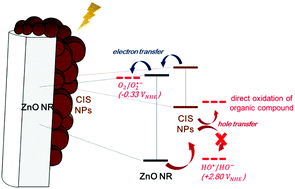当前位置:
X-MOL 学术
›
Photochem. Photobiol. Sci.
›
论文详情
Our official English website, www.x-mol.net, welcomes your
feedback! (Note: you will need to create a separate account there.)
Environmentally benign synthesis of CuInS2/ZnO heteronanorods: visible light activated photocatalysis of organic pollutant/bacteria and study of its mechanism
Photochemical & Photobiological Sciences ( IF 2.7 ) Pub Date : 2017-10-19 00:00:00 , DOI: 10.1039/c7pp00248c Minki Baek 1, 2, 3, 4, 5 , Eun-Ju Kim 5, 6, 7, 8 , Seok Won Hong 5, 6, 7, 8 , Wooyul Kim 9, 10, 11, 12, 13 , Kijung Yong 1, 2, 3, 4, 5
Photochemical & Photobiological Sciences ( IF 2.7 ) Pub Date : 2017-10-19 00:00:00 , DOI: 10.1039/c7pp00248c Minki Baek 1, 2, 3, 4, 5 , Eun-Ju Kim 5, 6, 7, 8 , Seok Won Hong 5, 6, 7, 8 , Wooyul Kim 9, 10, 11, 12, 13 , Kijung Yong 1, 2, 3, 4, 5
Affiliation

|
Due to its high light absorption coefficient and appropriate bandgap, CuInS2 (CIS) has been receiving much attention as an absorber material for thin film solar cells and also as a visible light photocatalyst. Herein we present heterostructured CIS/ZnO nanorods (NRs) in an attempt to enhance light absorption and facilitate charge separation/transfer in the photocatalysis system. CIS nanoparticles (NPs) were directly deposited on ZnO nanorod arrays (NRAs) to fabricate heterostructured CIS/ZnO NRAs using an environmentally benign, non-hydrazine solution reaction. These heterostructured NRAs are immobilized on FTO glass, which has additional merits of recyclability and bias-applicability. The ideal type-II band structure of CIS/ZnO enables efficient charge separation/transfer, which is confirmed by PL (photoluminescence) decay measurements. Also, the 1D-ZnO NR structure facilitates fast charge transfer along with enhancing light absorption via light scattering. These synergistic effects improved the photocatalytic activity in both organic dye and bacteria decomposition. The photodecomposition efficiency was further enhanced with an aid of external bias. The underlying photocatalytic mechanism was also investigated through controlled experiments under various scavenging conditions. The results suggest that reactive oxygen species (ROS) formed by multistep reduction of O2 play a main role in photocatalysis, while hole-induced photodecomposition is relatively deactivated due to the band structure of the heterostructures of CIS/ZnO.
中文翻译:

CuInS 2 / ZnO杂合子的环境友好合成:可见光活化的有机污染物/细菌光催化作用及其机理研究
由于其高的光吸收系数和适当的带隙,CuInS 2CIS(CIS)作为薄膜太阳能电池的吸收材料以及可见光光催化剂受到了广泛的关注。本文中,我们提出异质结构的CIS / ZnO纳米棒(NRs),以尝试增强光吸收并促进光催化系统中电荷的分离/转移。CIS纳米颗粒(NPs)直接沉积在ZnO纳米棒阵列(NRA)上,以利用环境友好的非肼溶液反应制造异质结构的CIS / ZnO NRA。这些异质结构的NRA被固定在FTO玻璃上,这具有可回收性和偏压适用性的其他优点。CIS / ZnO的理想II型能带结构能够实现有效的电荷分离/转移,这已通过PL(光致发光)衰减测量得到了证实。还,通过光散射。这些协同作用改善了有机染料和细菌分解中的光催化活性。借助外部偏压进一步提高了光分解效率。还通过在各种清除条件下的受控实验研究了潜在的光催化机理。结果表明,由O 2的多步还原形成的活性氧(ROS)在光催化中起主要作用,而空穴诱导的光分解由于CIS / ZnO异质结构的能带结构而相对失活。
更新日期:2017-11-08
中文翻译:

CuInS 2 / ZnO杂合子的环境友好合成:可见光活化的有机污染物/细菌光催化作用及其机理研究
由于其高的光吸收系数和适当的带隙,CuInS 2CIS(CIS)作为薄膜太阳能电池的吸收材料以及可见光光催化剂受到了广泛的关注。本文中,我们提出异质结构的CIS / ZnO纳米棒(NRs),以尝试增强光吸收并促进光催化系统中电荷的分离/转移。CIS纳米颗粒(NPs)直接沉积在ZnO纳米棒阵列(NRA)上,以利用环境友好的非肼溶液反应制造异质结构的CIS / ZnO NRA。这些异质结构的NRA被固定在FTO玻璃上,这具有可回收性和偏压适用性的其他优点。CIS / ZnO的理想II型能带结构能够实现有效的电荷分离/转移,这已通过PL(光致发光)衰减测量得到了证实。还,通过光散射。这些协同作用改善了有机染料和细菌分解中的光催化活性。借助外部偏压进一步提高了光分解效率。还通过在各种清除条件下的受控实验研究了潜在的光催化机理。结果表明,由O 2的多步还原形成的活性氧(ROS)在光催化中起主要作用,而空穴诱导的光分解由于CIS / ZnO异质结构的能带结构而相对失活。










































 京公网安备 11010802027423号
京公网安备 11010802027423号